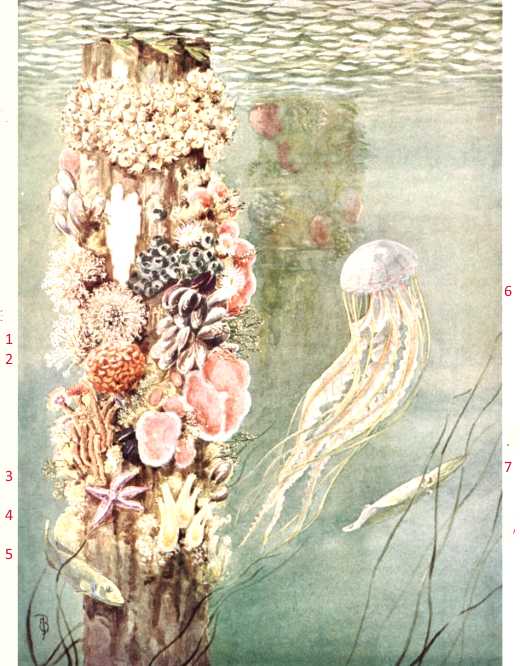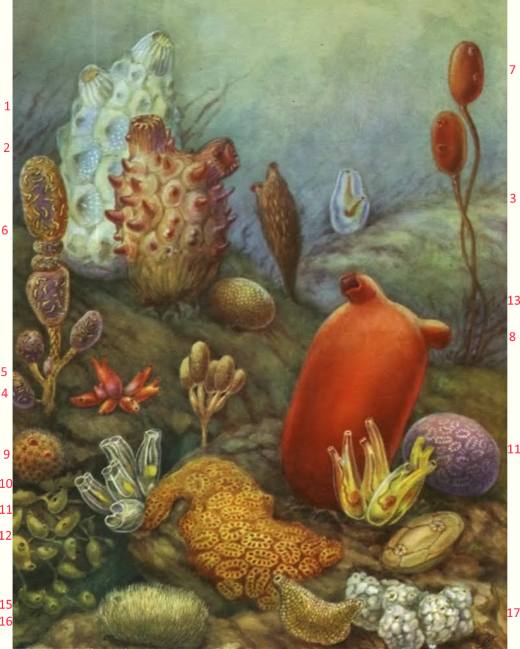Vase tunicate
Ciona intestinalis is a solitary tunicate with a cylindrical, soft, gelatinous body, that is almost transparant.
If the intestines are filled with food particles they can easely be seen from the outside,
Ciona intestinalis grows in the lower intertidal to sub-tidal zones, but also on pilings, aquaculture gear,
and harbor equipement and hulls.
Vase tunicate is an invasive species
The Vase tunicate is widely distributed in Northern European waters. It has spread to other parts of the world, and can be found nowadays in all the oceans and seas. Tne vase tunicate threaten the shellfish aquaculture industry in some parts of the world, like Prince Edward Island, Canada. Ciona intestinalis continues to colonize this estuary at epidemic proportions, competing with mussel cultures. In the Netherlands the Vase tunicate is abundant in the Oosterschelde reaching high densities and competing with the important mussel cultures. There is competion for food: both the mussels and the vase tunicate filter plankton. There is also competition for space: the vase tunicate covers the bottom with a blanket of sea squirts.

Vase tunicate is a solitary tunicate but can form dense blankets on the sea bottom. They are about 15 cm long.

Live on a wooden pile: limpets, barnacles, goose barnacle, bivalves and anemoons inhibit the upper parts.
1 Clavelina lepadiformis or light-bulb tunicate
2 mussel
3 common seastar or starfish
4 vase tunicate or Ciona intestinalis
5 Atlantic cod
6 moon jelly or Aurelia aurita
7 European squid or Loligo vulgaris
Reproduction
Ciona intestinalis is like all sea squirt hermaphroditic
and releases the eggs and sperm directly into the water.
But not at the time.
The eggs and sperm have two days to find each other.
The fertilized egg transforms into a tadpole-like larve that has a lifetime of not much more then a week.
The larve swimms around until it has found a place to settle.
Here the vase like structure develops.

1 White sea-squirt or Phallusia mammillata
2 Pyura microcosmus
3 vase tunicate or ciona intestinalis
4 red sea squirt or Halocynthia papillosa
5 star ascidian or or Botryllus schlosseri or Polycyclus renieri
6 Botrylloides rubrum

Tunicata of the Arctic and Atlantic ocean.
1 Phallusia mammillata
2 sea pineapple or Halocynthia roretzi
3 Ascidia virginea
4 Lesser Gooseberry Sea Squirt or distomus variolosus
5 Sycozoa umbellata
6 Styela clavata
7 sea potato or Boltenia ovifera
8 Sea peach or Halocynthia aurantium
9 cactus sea squirt or Boltenia echinata
10 light-bulb tunicata
11 star ascidian or golden star or Botryllus schlosseri
12 Ecteinascidia tortugensis
13 Elephant ear ascidian or Gynandrocarpa placenta
14 Vase tunicate or Ciona intestinalis
15 Pyura setosa
16 Pyura Molina
17 Styela plicata